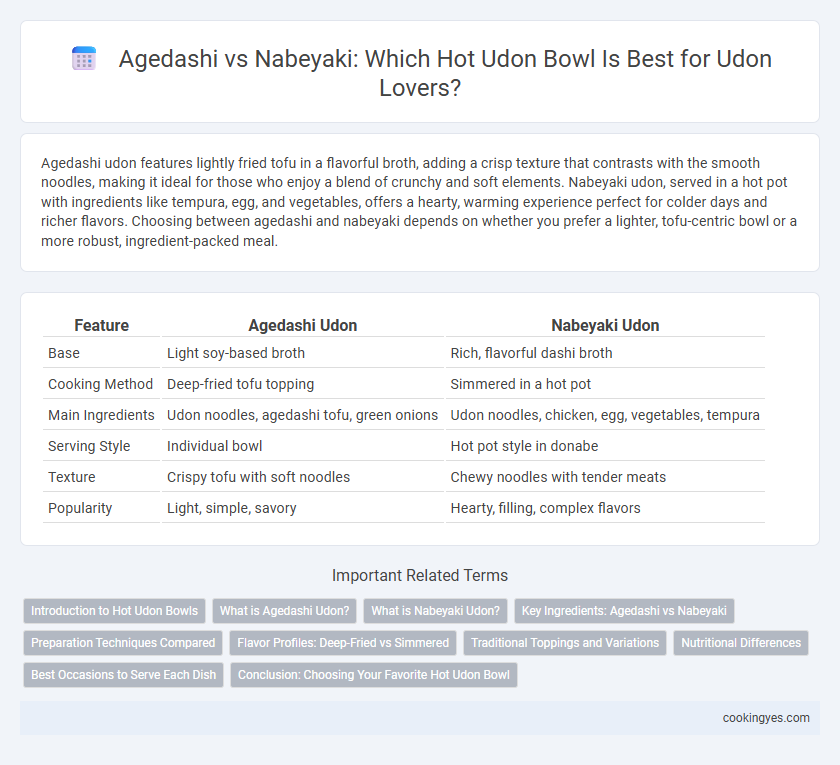Agedashi udon features lightly fried tofu in a flavorful broth, adding a crisp texture that contrasts with the smooth noodles, making it ideal for those who enjoy a blend of crunchy and soft elements. Nabeyaki udon, served in a hot pot with ingredients like tempura, egg, and vegetables, offers a hearty, warming experience perfect for colder days and richer flavors. Choosing between agedashi and nabeyaki depends on whether you prefer a lighter, tofu-centric bowl or a more robust, ingredient-packed meal.
Table of Comparison
| Feature | Agedashi Udon | Nabeyaki Udon |
|---|---|---|
| Base | Light soy-based broth | Rich, flavorful dashi broth |
| Cooking Method | Deep-fried tofu topping | Simmered in a hot pot |
| Main Ingredients | Udon noodles, agedashi tofu, green onions | Udon noodles, chicken, egg, vegetables, tempura |
| Serving Style | Individual bowl | Hot pot style in donabe |
| Texture | Crispy tofu with soft noodles | Chewy noodles with tender meats |
| Popularity | Light, simple, savory | Hearty, filling, complex flavors |
Introduction to Hot Udon Bowls
Agedashi udon features lightly battered and deep-fried tofu served in a savory dashi broth, offering a crispy texture paired with rich umami flavors. Nabeyaki udon is a hearty hot pot-style dish cooked with ingredients like chicken, vegetables, and a soft-boiled egg, delivering a robust and warming meal. Both varieties showcase the comforting warmth and depth of Japanese culinary tradition in hot udon bowls.
What is Agedashi Udon?
Agedashi Udon features deep-fried tofu cubes served atop a hot udon noodle soup, creating a crispy contrast to the tender noodles and savory dashi broth. This dish emphasizes texture and umami, with the fried tofu absorbing the flavorful soup while retaining a slightly crunchy exterior. Its rich, comforting profile distinguishes it from Nabeyaki Udon, which typically includes various simmered ingredients cooked directly in a hot pot.
What is Nabeyaki Udon?
Nabeyaki udon is a hot Japanese noodle bowl served in a thick, earthenware pot that keeps the broth simmering throughout the meal. It typically features thick udon noodles, a flavorful dashi broth, tempura shrimp, chicken, mushrooms, kamaboko (fish cake), and a partially cooked egg that adds richness. This hearty, warming dish contrasts with agedashi udon, which usually consists of fried tofu served in a lighter broth without the variety of toppings and cooking method found in nabeyaki udon.
Key Ingredients: Agedashi vs Nabeyaki
Agedashi udon features key ingredients like lightly battered and deep-fried tofu served in a flavorful dashi-based broth, often garnished with grated daikon and green onions for a fresh contrast. Nabeyaki udon highlights hearty components such as soft-boiled eggs, chicken, shiitake mushrooms, and seasonal vegetables, simmered together in a rich, soy-flavored broth inside a clay pot. Both dishes emphasize umami-rich broths but differ in texture and ingredient density, with Agedashi offering a crispy softness and Nabeyaki presenting a robust, stew-like experience.
Preparation Techniques Compared
Agedashi udon features deep-fried tofu cubes simmered in a dashi-based broth, emphasizing a crispy exterior that softens upon soaking, combining contrasting textures in each bite. Nabeyaki udon involves simmering udon noodles with ingredients like chicken, mushrooms, and raw egg inside a clay pot, creating a rich, layered flavor profile through slow, even heat. The preparation techniques highlight Agedashi's quick frying and soaking method versus Nabeyaki's extended, gentle simmering, catering to different texture and taste experiences.
Flavor Profiles: Deep-Fried vs Simmered
Agedashi udon features crispy, deep-fried tofu that imparts a rich, savory crunch, complementing the light soy-based broth with a satisfying texture contrast. Nabeyaki udon, simmered with ingredients like chicken, mushrooms, vegetables, and a soft-boiled egg, offers a hearty, umami-packed flavor resulting from slow cooking in a flavorful dashi broth. The deep-fried intensity of Agedashi balances boldness and crispness, while Nabeyaki delivers a comforting, simmered complexity perfect for rich, warming udon bowls.
Traditional Toppings and Variations
Agedashi udon features deep-fried tofu cubes as its traditional topping, providing a crispy texture that contrasts with the soft noodles and dashi broth, often complemented by green onions, grated daikon, and bonito flakes. Nabeyaki udon is served in a hot pot with a variety of toppings including tempura shrimp, egg, kamaboko fish cake, and vegetables, offering a richly layered and hearty flavor profile. Variations in nabeyaki may include different protein choices like chicken or mushrooms, while agedashi remains focused on the signature tofu preparation.
Nutritional Differences
Agedashi udon features deep-fried tofu that adds protein and fat, resulting in a richer calorie content compared to Nabeyaki udon, which incorporates lighter ingredients like chicken, vegetables, and egg. Nabeyaki udon provides a balanced supply of protein and vitamins with lower fat levels, making it a healthier option for those monitoring intake. Both dishes offer comfort and warmth, but Nabeyaki is typically preferred for a nutrient-dense, lower-calorie hot udon bowl.
Best Occasions to Serve Each Dish
Agedashi udon, featuring crispy tofu in a light dashi broth, is ideal for casual dinners and when craving a comforting yet refreshing meal, especially during mild weather. Nabeyaki udon, served piping hot with ingredients like tempura, egg, and vegetables in a rich, flavorful broth, excels in colder months or special gatherings where warmth and heartiness are desired. Serving agedashi udon in spring or autumn accentuates its delicate textures, while nabeyaki udon's robust composition suits winter evenings and festive occasions.
Conclusion: Choosing Your Favorite Hot Udon Bowl
Agedashi udon features crispy tofu soaked in savory broth, delivering a contrast of textures that enhances the richness of the dish. Nabeyaki udon offers a hearty experience with simmered ingredients like chicken, vegetables, and egg in a hot, thick broth, providing comforting depth and warmth. Selecting your favorite depends on whether you prefer a crisp, light texture or a robust, filling bowl packed with a variety of flavors.
Agedashi vs Nabeyaki for hot udon bowls Infographic

 cookingyes.com
cookingyes.com